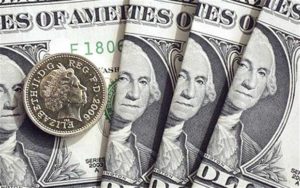 Yesterday’s trade saw GBP/USD within the range of 1.4402-1.4473. The pair closed at 1.4405, inching down 0.08% compared to Wednesdays close. It has been the 30th drop in the past 50 trading days and also a third consecutive one. The major pair has lost 0.45% of its value so far in June, following a 0.92% drop in the prior month.
Yesterday’s trade saw GBP/USD within the range of 1.4402-1.4473. The pair closed at 1.4405, inching down 0.08% compared to Wednesdays close. It has been the 30th drop in the past 50 trading days and also a third consecutive one. The major pair has lost 0.45% of its value so far in June, following a 0.92% drop in the prior month.
At 6:28 GMT today GBP/USD was inching up 0.07% on the day to trade at 1.4415. The pair touched a daily high at 1.4427 during early Asian trade, overshooting the range resistance level (R3), and a daily low at 1.4400 during the early phase of the Asian trading session as well.
On Friday GBP/USD trading may be influenced by the following macroeconomic reports as listed below.
Fundamentals
United Kingdom
Services PMI by Markit/CIPS
Activity in United Kingdom’s sector of services probably increased at a slightly higher rate in May compared to a month ago, with the corresponding PMI coming in at 52.5, up from 52.3 in April. If market expectations were met, May would be the 41st consecutive month, when the gauge inhabited the area above 50.0. Aprils reading has been the lowest since February 2013, as economic uncertainty, partly related to the EU membership referendum, seemed to have affected UK growth. A number of respondents in the survey noted the delayed placement of new contracts by customers. On the other hand, new business growth slightly accelerated in April, while employment growth continued to increase.
The index is based on a survey, encompassing managers of companies, that operate in sectors such as transportation, communications, IT, financial intermediation, tourism. They are asked about their estimate regarding current business conditions (new orders, output, employment, demand in the future). Values above the key level of 50.0 signify predominant optimism (expansion in general activity). A larger-than-projected acceleration in the index would have a moderate bullish effect on the Pound. The Chartered Institute of Purchasing and Supply (CIPS) is expected to release the official reading at 8:30 GMT.
United States
Non-farm Payrolls, Unemployment Rate, Average Hourly Earnings
Employers in all sectors of economy in the United States, excluding the farming industry, probably added 162 000 new jobs in May, according to the median forecast by experts, after a job gain of 160 000 in April. The latter has been the slowest growth rate since September 2015, when a revised down figure of 137 000 was reported.
Employment in professional and business services rose by 65 000 in April, in health care – by 44 000, in financial activities – by 20 000. At the same time, employment in the US mining sector shrank by 7 000 during the month, according to the report by the Bureau of Labor Statistics (BLS). Employment in other key industries such as construction, manufacturing, wholesale trade, retail trade, transportation and warehousing, information, leisure and hospitality, and government remained little changed during the period.
Total non-farm payrolls account for 80% of the workers, who produce the entire Gross Domestic Product of the United States. Therefore, in case of a larger-than-expected gain in jobs in May, demand for the US dollar would be strongly supported.
Average Hourly Earnings probably increased 0.2% in May compared to the prior month, according to market expectations, following another 0.3% gain to USD 25.53 in April.
Meanwhile, the rate of unemployment in the country probably dropped to 4.9% in May, according to market expectations, from 5.0% in April. If expectations were met, this would be the lowest unemployment since February.
The total number of people unemployed was almost unchanged at 7.9 million in April, while more persons dropped out of the labor force. Among major groups, the unemployment rate for Hispanics rose to 6.1% during the period, while the rates for adult men (4.6%), adult women (4.5%), teenagers (16.0%), Whites (4.3%), Blacks (8.8%) and Asians (3.8%) remained almost without change.
The number of long-term unemployed (those looking for employment for 27 weeks or more) dropped by 150 000 to 2.1 million during April and comprised 25.7% of the unemployed, according to the BLS. At the same time, the number of persons in part-time employment for economic reasons (involuntary part-time workers) was little changed at 6.0 million in April.
In case the unemployment rate met expectations or even fell further in May, this would have a strong bullish effect on the greenback, because of the positive implications for consumer spending. The Bureau of Labor Statistics will release the official employment report at 13:30 GMT.
Balance of Trade
The deficit on US balance of trade probably widened to USD 41.30 billion in April, according to market expectations, from a deficit figure of USD 40.40 billion in March. The latter has been the smallest monthly trade deficit since February 2015, when a revised up gap of USD 35.89 billion was reported.
Total exports fell at a monthly rate of 0.87% in March to reach USD 176.6 billion. Exports of goods decreased USD 1.8 billion to reach USD 116.8 billion during the period, while exports of services went up USD 0.3 billion to reach USD 59.8 billion.
Total imports, at the same time, contracted at a monthly rate of 3.6% to reach USD 217.1 billion in March, or their lowest level since February 2011. Imports of goods were USD 7.9 billion lower to reach USD 175.3 billion during the period, while imports of services went down USD 0.2 billion to USD 41.7 billion.
In Q1, the average trade deficit shrank USD 1.4 billion, as imports fell USD 2.6 billion, while exports went down USD 1.2 billion.
In case the trade balance deficit widened more than anticipated, this would weigh on demand for the US Dollar, because of negative implications regarding economic growth. The Bureau of Economic Analysis will release the official trade data at 13:30 GMT.
Factory Orders
The total value of factory orders in the United States probably expanded 0.9% in April compared to March, according to the median estimate by experts, following a revised up 1.5% surge in the preceding month. The latter has been the steepest increase since June 2015. In March, orders for non-defense capital goods excluding aircraft, a gauge of business confidence and spending plans, shrank 0.8% compared to a 0.1% increase, as reported initially.
Excluding the sector of transportation, factory orders went up 0.8% in March from a month ago, while breaking a streak of four consecutive months of decline.
The general index reflects the total value of new purchase orders, placed at manufacturers for durable and non-durable goods, and can provide insight into inflation and growth in the US sector of manufacturing. In case the general index of new orders increased at a faster-than-anticipated rate, this would trigger a moderate bullish impulse for the US dollar, as it implies future growth acceleration. The US Census Bureau will release the official data at 14:00 GMT.
Non-Manufacturing PMI by the ISM
Activity in United States’ sector of services probably increased at a slightly lower pace in May from a month ago, with the corresponding non-manufacturing PMI coming in at a reading of 55.5, according to the median forecast by experts, down from a level of 55.7 in April. The latter has been the highest PMI reading since November 2015, when the gauge was reported at 55.9. If expectations were met, May would be the 77th consecutive month, when the gauge stood in the area above 50.0. The PMI is a compound index, based on the values of four equally-weighted components, which comprise it. These sub-indexes reflect seasonally adjusted new orders, seasonally adjusted employment, seasonally adjusted business activity and supplier deliveries.
The New Orders Index stood at 59.9 in April, up from a reading of 56.7 in the prior month. The Employment Index rose to 53.0 in April from 50.3 in March, while indicating a second consecutive period of expansion, according to data by the Institute for Supply Management (ISM). The Prices Index climbed to 53.4 in April from 49.1 in March, which indicated prices went up for the first time in the past 3 months. The Non-Manufacturing Business Activity Index decreased to 58.8 in April from a reading of 59.8 in March, indicating growth for an 81st straight month.
Among the 17 services industries, 13 reported growth and 4 reported contraction in activity in April.
In case the PMI slowed down more than anticipated in May, this would have a strong bearish effect on the US Dollar. The Institute for Supply Management (ISM) is to release the official reading at 14:00 GMT.
Daily and Weekly Pivot Levels
By employing the Camarilla calculation method, the daily pivot levels for GBP/USD are presented as follows:
R1 – 1.4412
R2 – 1.4418
R3 (range resistance) – 1.4425
R4 (range breakout) – 1.4444
S1 – 1.4398
S2 – 1.4392
S3 (range support) – 1.4385
S4 (range breakout) – 1.4366
By using the traditional method of calculation, the weekly pivot levels for GBP/USD are presented as follows:
Central Pivot Point – 1.4603
R1 – 1.4765
R2 – 1.4906
R3 – 1.5068
S1 – 1.4462
S2 – 1.4300
S3 – 1.4159





